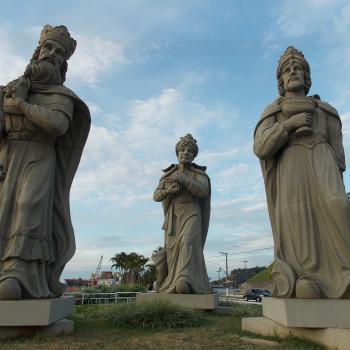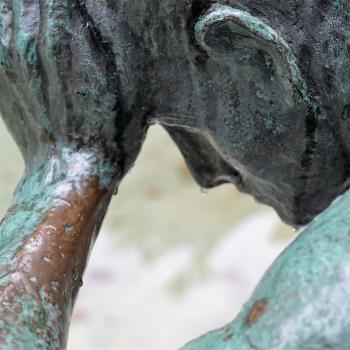
Augustine is going to take us on a deep, inner journey to the center of the soul, there to look for shadows of the Trinitarian image, and from that vision to return to the greater vision of the One who is Three. We are made in God’s image (imago dei), and we are called to be like Christ (imago Christi). Our origin and our destiny are imprinted with the divine.
How great is the love the Father has lavished on us, that we should be called children of God! And that is what we are! . . . Dear friends, now we are children of God, and what we will be has not yet been made known. But we know that when he appears, we shall be like him, for we shall see him as he is (1 Jn. 3.1-2).
This is a great mystery—this vast arc from creation to glory, drawing us ever into an endless encounter with God, shining and incomprehensible.
But Augustine is not the only one to have seen the Trinity writ small on the soul and in our lives, and so before we explore Augustine’s famous analogy of memory-intellect-will or remembering-understanding-loving as echoes of the divine, I thought we’d listen to a homier voice, a smaller, gentler celebration of the threesomeness of human experience: Julian of Norwich.
Augustine was prolific, writing hundreds of sermons, volumes of books. This 14th-century woman passes down to us one major work—in two versions, long and short—that captures her lifetime of prayer and meditation on God. One book: passion-filled, wondrous, and worshipful.
Julian is gripped by the Trinity. Everywhere she looks, every probing of thought and hope, reveals three facets of spiritual growth and desire. When she looks at God, she sees Threeness; when she looks at Christ, she sees Threeness; when she looks at our life in Christ, she sees Threeness.
In one of her early visions, God “showed her a little thing, the size of a hazelnut, lying in the palm of her hand.” What is it? It is, the Lord tells her, everything that has been made. “I marveled how this could be, for it seemed to me that it might suddenly fall into nothingness, it was so small.” God answers her with the assurance that it exists because he loves it; that “all things have their being by the grace of God.”
In this little thing, I saw three properties. The first is that God made it. The second is that God loves it. The third is that God keeps it. But I cannot tell the reality of him who is my maker, lover, and keeper, for until I am united to him in substance, I may never have complete rest or real bliss . . . (chap. 5).
For Julian, the Threeness in God envelops all that is in creating love and sustaining grace. God is our maker, lover, and keeper. The Three activities become visible in the hazelnut, in all created things, in her soul.
This echoes one of Gregory of Nyssa’s reflections. As he explored the Threeness of God evident in scripture, he saw “distinguishing marks” of each Person, characteristics of each Person’s activities. Even as they share completely in purpose and energy, they each act according to their Person.
The Father originates, is the begetter; the Son shines, is begotten; the Spirit moves, is breathed.
As Anatolios describes it, “every activity (energeia) reaching from God to creation . . . originates in the Father, proceeds through the Son, and is completed in the Holy Spirit. . . . But whatever happens in the course of the providence towards us or the management and constitution of the universe happens through the Three and yet does not result in three happenings.”
Their unity and their activities work in diversity and in complete synchronicity, each acting in and through the other, so that, as Gregory tells us (via Anatolios) each Person does what he is, not that each Person is what he does. This is not a functional or economic description of the Trinity, as if we only know the Three as they are defined by their roles; we eliminated that interpretation early in this series. But their roles make visible their distinctions. Anatolios again: “the one divine activity is completely effected by each of the persons and yet is distinctly inflected between them.”
The Father is the Giver; the Son is the Bearer; the Spirit is the Gift. Maker (Giver of Life), Lover (Bearer of Life), Keeper (Gift of Life).
And Gregory reminded us that as this truth about the nature of God seeps into our soul and becomes real knowledge—as has been said, it takes two to make a revelation: a giver and a receiver, a revealer and a witness—this will lead to wonder and praise. If it doesn’t, if this produces some objectively satisfactory answer accompanied by a discreet yawn, you do not yet have the “necessary knowledge,” (1 Cor. 8.2), you have not received the revelation. You’ll know if you’ve been given a revelation of the Three when you fall on your face with joy and worship.
Julian knew this:
Suddenly the Trinity completely filled my heart with the greatest joy. And so, I understood, it will be in heaven, without an end, for those who come there. For the Trinity is God; God is the Trinity. The Trinity is our maker. The Trinity is our keeper. The Trinity is our everlasting lover. The Trinity is our endless joy and our bliss, through our Lord Jesus Christ and in our Lord Jesus Christ. This truth was show in the first showing and in all the showings, for where Jesus appears, the blessed Trinity is understood, as I see it (chap. 4).
Endless joy and bliss.
But Julian recognizes that this “endless joy and bliss” is not a zap-bam wonder wand hitting us over the head. This is what makes her work so real. God is not the fairy godmother, and Cinderella does not move out of the cellar into the castle. In all her reflections on God’s Threefold love and grace and constant care, Julian weaves the darker threads of wrath, penance, sin, and struggle.
All of us who shall be saved have within us during our lifetime a marvelous mixture of both well-being and woe. . . . By Adam’s falling we are so broken in our feelings in different ways (by sin and by various pains in which we are made dark and so blind), that only with difficulty can we take any comfort. But in our intentions we wait for God and faithfully trust we shall have mercy and grace—and this is his own working in us. By his goodness it opens the eye of our understanding, in which we have sight, sometimes more, sometimes less, as God gives us the ability to accept it. Now we are raised to the one and now we are allowed to fall into the other. And thus the mixture in us is so puzzling that it is with difficulty that we know of ourselves or of our fellow Christians how we stand, with the strangeness of these different feelings (chap. 52).
How do we live like this? How, then, can we strain toward the Trinity when we are so darkened in understanding, burdened by confusion and grief? Julian’s answer is also Trinitarian. Even our struggle speaks to us of the Three at work in our soul. We seek him, that One, without rest, without despair, without impatience, and that very business of seeking “pleases our Lord.” Until God grants the finding, the seeing, the grace, God accepts our seeking itself as the act of the soul’s small, but precious, love. “Seeking is as good as seeing” during this time. Note her threefold-description of our seeking:
The seeking is a common work which every soul can do with God’s grace; it ought to be done with discretion and the teaching of holy Church. It is God’s will that we have three things in our seeking of him. The first is that we seek him determinedly and diligently without sloth, as well as we can, through his grace, and that we do so gladly and merrily, without unreasonable depression and vain sorrow.
The second is that for love of him we wait for him steadfastly, without grumbling and striving against him, to the end of our lives: for it will only last for a little while.
The third is that we trust very strongly in him, in the full certainty of faith. For it is his will that we know that he shall appear suddenly and blissfully to all his lovers. His working is in secret, and yet he wills to be perceived; his appearing will be very sudden, and he wills to be trusted, for he is very near at hand, friendly and courteous, blessed may he be! (chap. 10).
Seeking without sloth, depression, vain sorrow, grumbling, or doubting.
Seeking with merriness, with surety, and with eager expectation.
Thus does Julian see the Triune One acting both in the world and in her own life, and thus does she let the Threeness of God’s goodness reverberate in her own actions toward him.
Augustine was a much learned man. Trained by the best in the Church. Literate, powerful, profound. Here a humble Englishwoman, a recluse in a cell in eastern England, receives her heart’s desire: a vision of the One who envelops her as the Three.
Truth sees God, and wisdom contemplates God. From these two comes the third, which is a holy, marvelous delight in God, who is love. Where truth and wisdom are, in truth, there is love, coming in reality from both of them, and all are of God’s making. For he is endless sovereign truth, endless sovereign wisdom and endless sovereign love, all of them uncreated (chap. 44).
Perhaps the tenderness of her vision can help us with Augustine’s more rigorous arguments. Though he, too, after building a dense theological argument, dissolves in love, writing
To the memory, sight, and love of this supreme trinity, in order to recollect it, see it, and enjoy it, he should refer every ounce and particle of his life.
Note to Reader: This series on Trinitarian Spirituality explores the history and spirituality behind the shaping of the Nicene Creed using Khaled Anatolios’ Retrieving Nicaea: The Development and Meaning of Trinitarian Doctrine (Grand Rapids, MI: Baker Academic, 2011) as guide and inspiration. It’s best to begin at the beginning: An Introduction.












